As autumn’s crisp air signals the changing seasons, we’re reminded that fall gardening offers some of the most rewarding opportunities of the year. Many gardeners mistakenly believe their growing season ends with summer, but we know better – fall gardens can be just as vibrant and productive as their spring counterparts.
The cooler temperatures and increased rainfall create perfect conditions for a variety of plants that actually prefer autumn weather. From colorful cold-season vegetables to stunning ornamental displays, we’ve discovered that fall gardens require less watering and face fewer pest challenges than summer plantings.
Whether you’re looking to extend your harvest season with hearty vegetables or create a spectacular autumn industry with seasonal flowers and foliage, we’ll share practical ideas that’ll transform your outdoor space into a fall paradise. Let’s explore how to make the most of this often-overlooked growing season.
Plant Cool-Season Vegetables for Fresh Harvests
Cool-season vegetables truly shine when autumn temperatures drop, offering gardeners the opportunity to enjoy fresh produce well into winter. We’ve found that these hardy crops actually prefer the cooler weather and often produce sweeter, more flavorful harvests than their summer counterparts.
Root Vegetables That Thrive in Fall
Carrots develop their signature sweetness when grown in fall conditions. We recommend planting varieties like ‘Nantes’ or ‘Chantenay’ about 10-12 weeks before your first hard frost. These orange beauties concentrate their sugars as temperatures cool, creating the perfect crunchy snack straight from the garden.
Radishes mature quickly in autumn’s moderate temperatures. Plant seeds every two weeks for continuous harvests, choosing varieties like ‘Cherry Belle’ for mild flavor or ‘Black Spanish’ for winter storage. Most radish varieties reach maturity in just 25-30 days during fall growing conditions.
Turnips and rutabagas flourish when planted in late summer for fall harvest. We’ve discovered that ‘Purple Top’ turnips and ‘American Purple Top’ rutabagas develop complex, nutty flavors when exposed to light frosts. These versatile roots store well in cool, humid conditions for months.
Beets produce tender leaves and sweet roots throughout the fall season. Varieties like ‘Detroit Dark Red’ and ‘Chioggia’ handle temperature drops remarkably well. We typically harvest baby beet greens within 30 days and full-sized roots after 55-60 days.
Leafy Greens for Continuous Production
Spinach grows vigorously in fall’s cooler temperatures without bolting to seed. We plant varieties like ‘Space’ and ‘Bloomsdale Long Standing’ every two weeks from late summer through early fall. These plants can withstand temperatures as low as 20°F with proper protection.
Lettuce varieties produce crisp, sweet leaves when grown in autumn conditions. Mix different types like butterhead ‘Boston’ lettuce, romaine ‘Winter Density’, and loose-leaf ‘Red Sails’ for diverse salad options. Fall-grown lettuce rarely experiences the bitter taste common in summer heat.
Arugula thrives in cool weather and adds peppery flavor to fall salads. We’ve found that ‘Astro’ and ‘Rocket’ varieties mature in just 40 days and continue producing leaves even after light frosts. Plant successive crops every three weeks for constant harvests.
Asian greens like bok choy and mizuna excel in fall growing conditions. These nutrient-dense vegetables prefer temperatures between 50-70°F and resist pest pressure that plagues summer crops. ‘Joi Choi’ bok choy and ‘Red Giant’ mustard greens add variety to autumn harvests.
Brassicas That Improve with Frost
Kale becomes sweeter and more tender after experiencing frost exposure. We grow varieties like ‘Winterbor’ and ‘Redbor’ that actually improve in flavor as temperatures drop below 32°F. These hardy plants continue producing leaves throughout winter in many regions.
Brussels sprouts develop their best flavor when harvested after frost touches the plants. Start seeds in midsummer for fall harvest, choosing varieties like ‘Long Island Improved’ or ‘Diablo’. We’ve noticed that cold temperatures convert starches to sugars, eliminating any bitter taste.
Cabbage varieties bred for fall growing withstand freezing temperatures remarkably well. Plant ‘January King’ or ‘Deadon’ cultivars that can survive temperatures as low as 10°F. These winter cabbages store exceptionally long when harvested before severe freezes arrive.
Broccoli produces larger, more flavorful heads during fall’s consistent cool weather. We plant ‘Belstar’ and ‘Imperial’ varieties in late summer for autumn harvests. Fall-grown broccoli rarely experiences the heat stress that causes summer crops to flower prematurely.
Create Stunning Fall Flower Displays
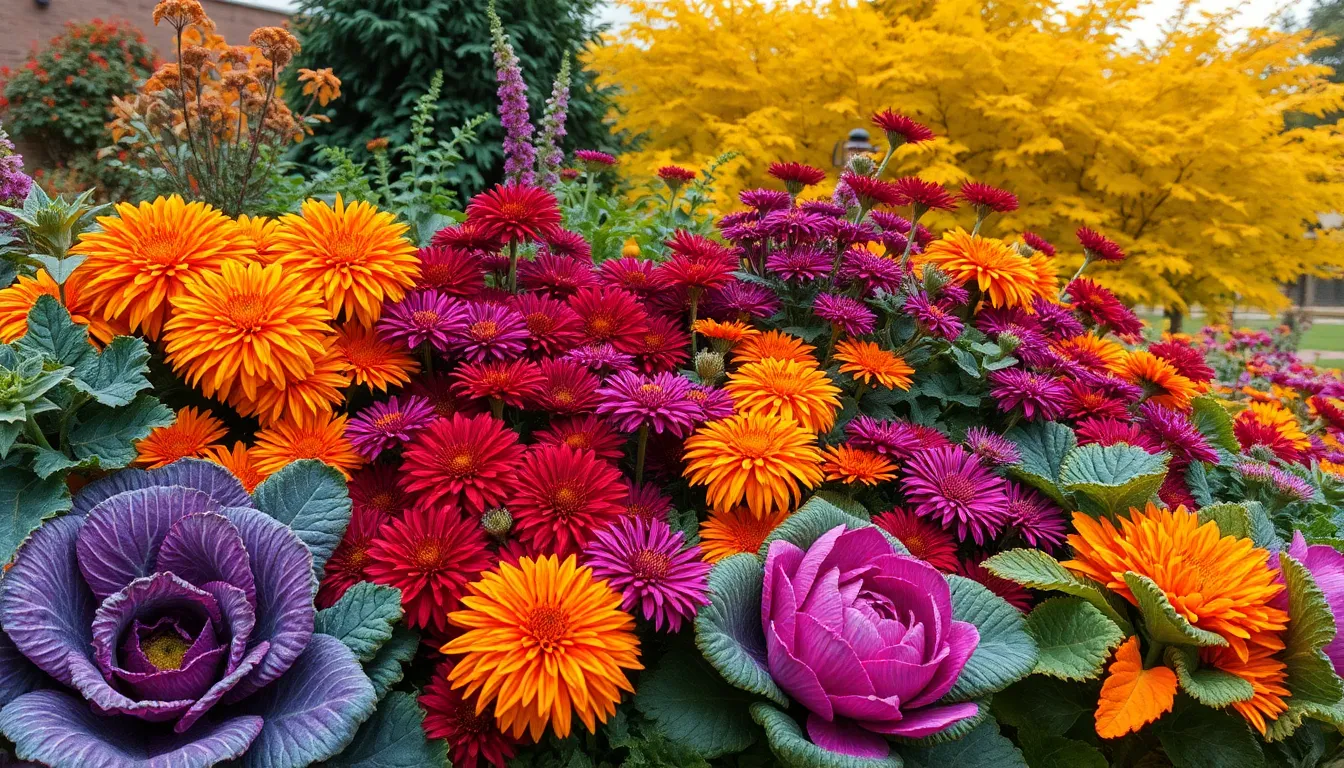
Transform your autumn garden into a vibrant showcase with carefully selected flowers that thrive in cooler temperatures. Fall blooms offer rich colors and textures that perfectly complement the season’s natural beauty.
Mums and Asters for Classic Autumn Color
Mums deliver the quintessential fall garden experience with their abundant blooms in deep oranges, burgundies, and golden yellows. These traditional autumn favorites come in various sizes from compact border plants to large statement pieces. Garden centers typically stock them in late summer, giving us plenty of options for creating dramatic displays.
Asters provide delicate daisy-like flowers that create beautiful contrasts in fall arrangements. We love how their pink, purple, and white blooms add softness to bolder autumn colors. Native varieties like New England asters attract beneficial pollinators while offering excellent cold tolerance.
Combining mums and asters creates layered displays that capture the essence of autumn. Plant larger mums as focal points and use asters to fill gaps with their airy texture. Both flowers continue blooming well into October and even November in milder climates.
Ornamental Kale and Cabbage for Texture
Ornamental kale brings dramatic foliage in shades of purple, pink, and cream that intensify as temperatures drop. The curly, ruffled leaves create striking textural elements that work beautifully in both containers and garden beds. Cool weather actually enhances their vibrant coloring, making them perfect for extended fall displays.
Ornamental cabbage offers smooth, rose-like formations that provide elegant structure to autumn gardens. These plants develop their best colors when nighttime temperatures consistently fall below 50°F. We recommend planting them in September for peak performance through the fall season.
Both varieties serve as excellent transitions between summer flowers and winter evergreens. Their architectural forms work particularly well in formal arrangements and provide lasting beauty even after first frosts. Consider pairing them with bronze-colored mums for sophisticated color combinations.
Fall-Blooming Perennials for Long-Lasting Beauty
Chrysanthemums anchor our fall perennial displays with their reliability and extensive color range. Hardy garden mums return year after year when planted in well-draining soil and given proper winter protection. September planting allows them to establish strong root systems before cold weather arrives.
Sedum varieties like ‘Autumn Joy’ and ‘Autumn Fire’ produce stunning flower heads that transition from green to pink to deep burgundy. Their succulent foliage provides year-round interest while their late-season blooms attract butterflies during their fall migration. These drought-tolerant perennials require minimal maintenance once established.
Ornamental grasses create movement and texture while offering spectacular fall color transformations. Fountain grass develops feathery plumes, while Japanese forest grass turns brilliant gold. We particularly appreciate how these plants provide winter interest with their dried seed heads and architectural forms.
Japanese maples serve as dramatic focal points with their incredible autumn foliage displays. Varieties like ‘Bloodgood’ and ‘Emperor I’ produce intense reds and oranges that complement fall flower colors perfectly. Plant them as backdrop elements to showcase smaller flowering plants in the foreground.
Prepare Your Garden for Winter Success
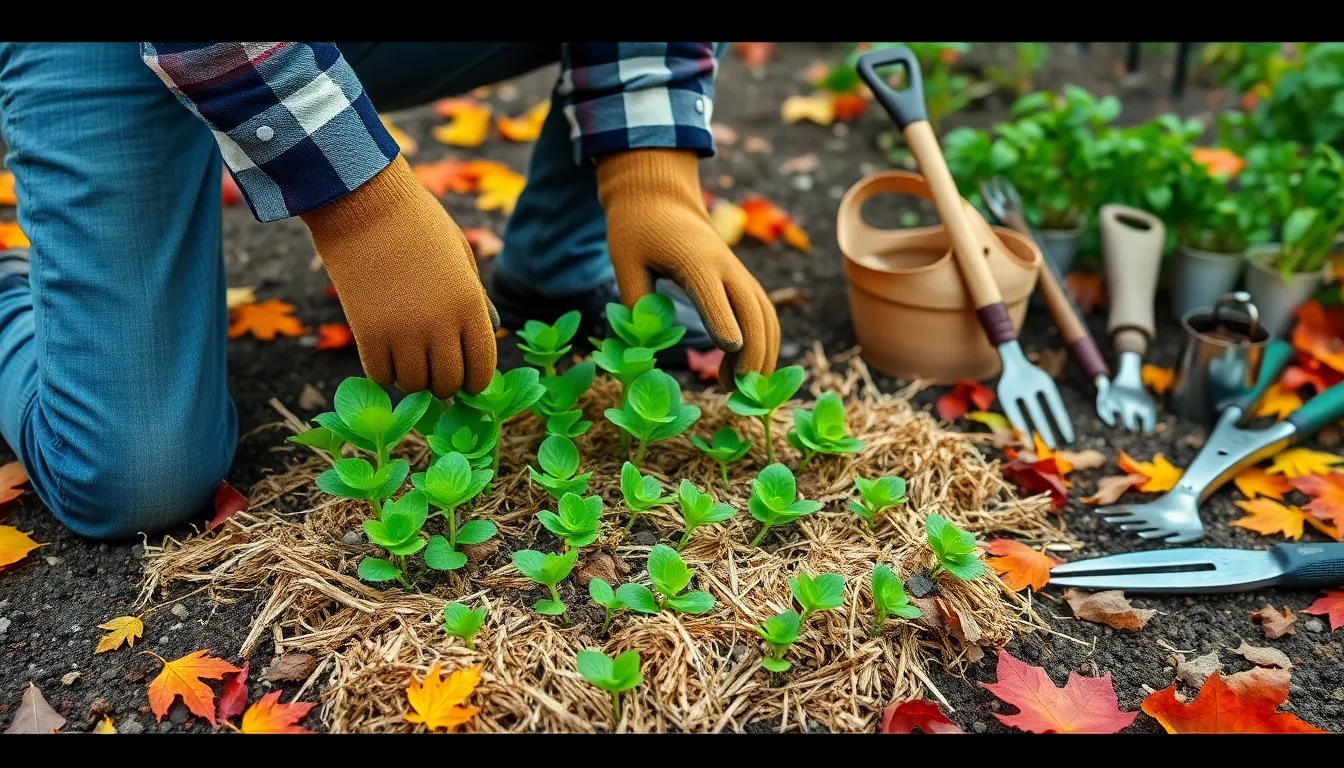
We’ve selected our fall crops and designed stunning seasonal displays, but now we must safeguard our garden investments against winter’s harsh conditions. Strategic preparation ensures our plants survive cold weather while setting the foundation for next year’s abundant growth.
Mulching Strategies for Plant Protection
Insulating mulch creates a protective barrier that shields plant roots from freezing temperatures and sudden weather changes. Straw works exceptionally well for cool-season vegetables like arugula, lettuce, and spinach because it traps warm air while allowing moisture to penetrate the soil. Burlap wrapping protects more delicate plants such as newly planted Brussels sprouts and cauliflower from harsh winds and frost damage.
Timing your mulch application correctly maximizes protection without encouraging pest problems or root rot. We recommend waiting until after the first light frost before applying a 3-4 inch layer around plants, as this maintains optimal soil temperature while suppressing winter weeds. Organic materials like leaf mold and wood chips continue decomposing slowly throughout winter, gradually enriching the soil beneath.
Different plants require exact mulching approaches based on their cold tolerance and growth patterns. Root vegetables like beets and radishes benefit from lighter mulch coverage that allows easy harvesting, while brassicas such as cabbage and broccoli need heavier protection around their base. Established perennials prefer coarse mulch that won’t compact and smother emerging shoots in spring.
Soil Amendment and Composting Techniques
Testing soil conditions before winter reveals nutrient deficiencies and pH imbalances that we can address during the dormant season. Fall soil tests help us determine which amendments to add, ensuring optimal growing conditions when spring planting begins. Most cool-season crops prefer slightly acidic to neutral soil with pH levels between 6.0 and 7.0.
Compost application during fall allows organic matter to break down slowly throughout winter, creating rich, fertile soil by spring. We spread 2-3 inches of well-aged compost around existing plants and work it into empty garden beds where we’ll plant next year. Fresh compost mixed with fallen leaves creates an excellent soil conditioner that improves drainage in clay soils and water retention in sandy conditions.
Cover crops planted in unused garden areas prevent soil erosion while adding essential nutrients naturally. Winter rye and crimson clover fix nitrogen in the soil, reducing our need for synthetic fertilizers next growing season. These living mulches also suppress weeds and provide habitat for beneficial insects that help control garden pests.
Tool Maintenance and Storage Answers
Cleaning gardening tools thoroughly prevents rust formation and disease transmission between growing seasons. We scrub soil and plant debris from shovels, pruners, and hoes using warm soapy water, then dry them completely before applying a thin coat of oil to metal surfaces. Hand tools like trowels and cultivators benefit from wire brush cleaning to remove stubborn dirt buildup.
Proper storage conditions extend tool lifespan significantly while keeping equipment readily accessible for winter garden tasks. Dry areas such as heated garages or tool sheds prevent moisture damage that leads to rust and wooden handle deterioration. Hanging tools on pegboards or wall-mounted racks keeps cutting edges sharp and prevents accidental damage from tools banging together.
Sharpening and oiling moving parts ensures tools perform efficiently when we need them for winter harvesting and spring preparation. Garden shears and pruning tools require regular blade sharpening using whetstones or professional services, while hinges and pivot points need light machine oil application. Well-maintained tools make fall garden tasks like harvesting Swiss chard and peas much more enjoyable and productive.
Design Eye-Catching Fall Container Gardens
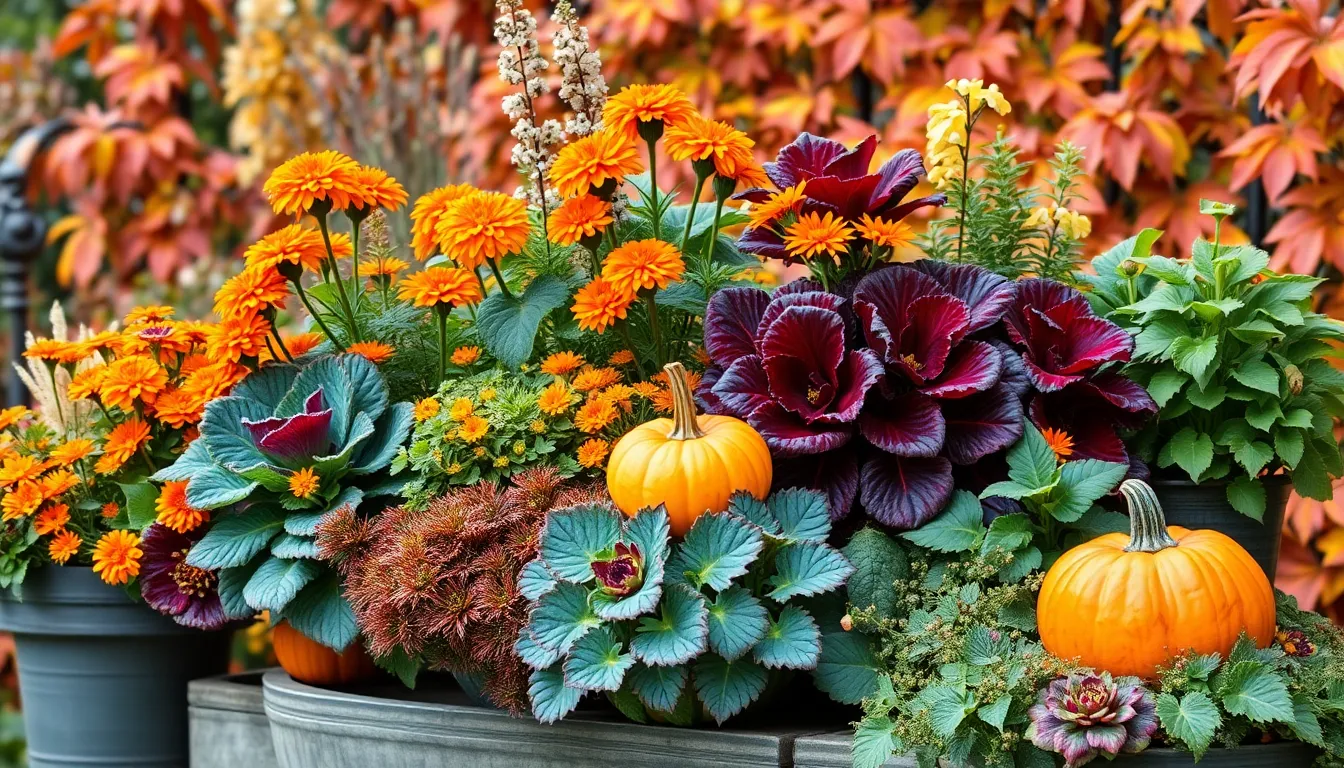
Container gardening offers endless possibilities for creating stunning autumn displays that complement your seasonal industry. We can transform any outdoor space with carefully planned container arrangements that capture fall’s vibrant spirit.
Seasonal Color Combinations That Pop
Warm autumn tones create the most dramatic fall container displays when we combine orange flowers like Campfire Fireburst bidens with deep red kale. These bold pairings reflect the season’s natural palette and draw attention from across the garden.
Sophisticated color schemes emerge when we mix black and purple foliage plants with sweet potato vine and coral bells. This elegant combination offers a sleek, modern appearance that stands out against traditional fall colors.
Thriller, filler, spiller arrangements work best when we use polka dot plants as eye-catching centerpieces, sedum varieties as mid-level fillers, and colorful grasses that spill gracefully over container edges. This layered approach creates visual depth and professional-looking displays.
Color blocked plantings achieve maximum impact when we group plants by similar hues rather than mixing them randomly throughout containers. We can create striking focal points by dedicating entire containers to exact color families.
Incorporating Fall Foliage and Berries
Classic autumn arrangements come alive when we combine pumpkins and gourds with lush green sedum and natural fall leaves. These elements create texture contrast while maintaining the seasonal theme throughout our container gardens.
Berry producing plants like diervilla add both color and wildlife interest to fall containers. We can position these plants strategically to create natural focal points that change throughout the season as berries ripen.
Natural foliage elements from our own yards can be incorporated into container designs without additional cost. Branches with colorful leaves, interesting bark textures, or unique shapes extend our design possibilities beyond purchased plants.
Layered textures develop when we combine smooth pumpkins with spiky grasses, broad-leafed plants, and delicate berry clusters. This mixing of different surface qualities creates visual interest that holds attention longer than single-texture displays.
Weather-Resistant Container Options
Self-watering planters help maintain consistent moisture levels during fall’s unpredictable weather patterns. These containers reduce our maintenance workload while protecting plants from both drought stress and overwatering issues.
Durable materials like stone-look composites and weather-treated wood withstand temperature fluctuations better than basic plastic containers. We can invest in quality containers that’ll serve multiple seasons without cracking or fading.
Proper drainage systems become crucial as fall rains increase and temperatures drop. We must ensure containers have adequate drainage holes and use quality potting mix that won’t become waterlogged during extended wet periods.
Size considerations matter more in fall container gardening since larger containers provide better insulation for plant roots. We recommend choosing containers at least 12 inches deep to protect plants from rapid temperature changes that smaller pots can’t buffer effectively.
Establish Trees and Shrubs for Future Growth
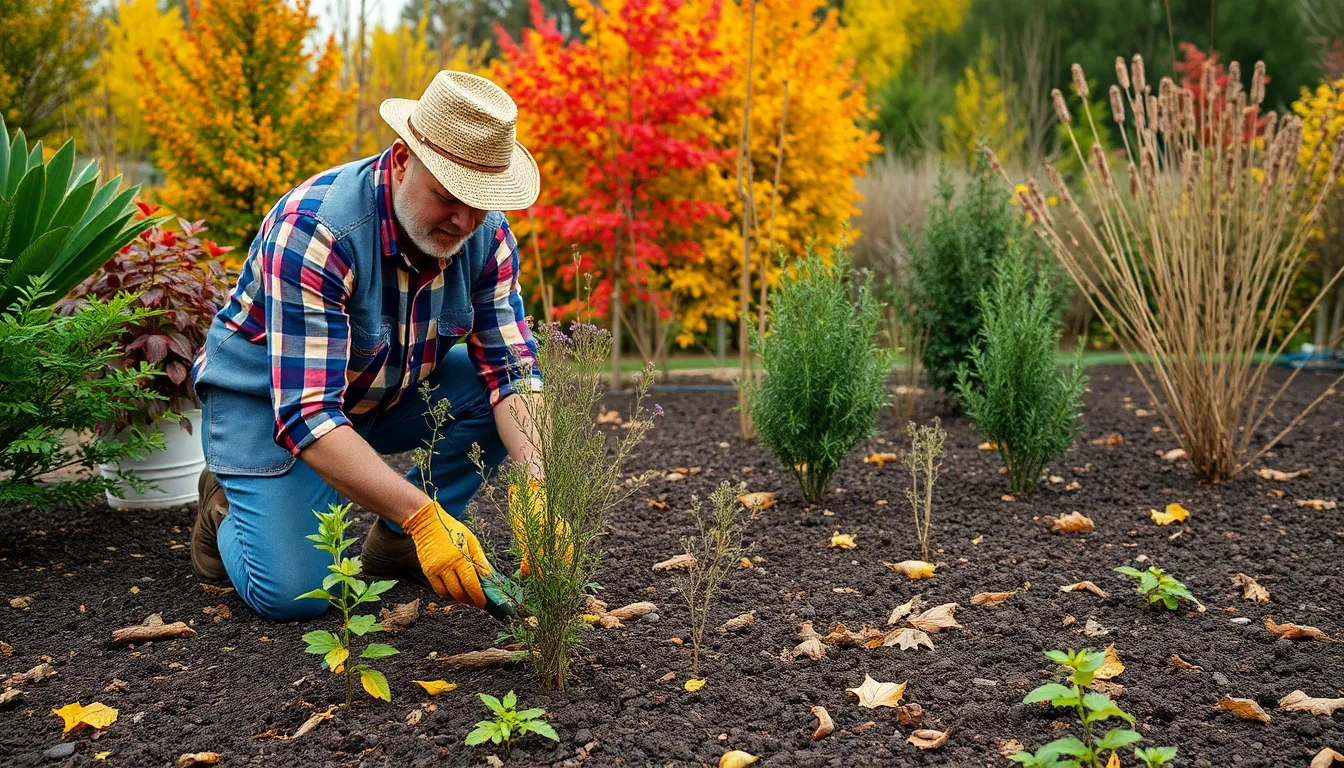
Fall presents the perfect window for establishing woody plants that’ll become the backbone of our industry. September through November offers optimal conditions for root development before winter dormancy sets in.
Best Fall Planting Practices
Timing matters most when we’re establishing new trees and shrubs in autumn. We should plant about six weeks before the first frost hits our area, giving roots adequate time to establish before winter arrives.
Soil preparation sets the foundation for successful plantings throughout the season. We need well-draining soil enriched with organic matter to support vigorous root growth during the critical establishment period.
Consistent watering becomes essential during fall months as plants develop their root systems. We must provide steady moisture without overwatering, helping plants build the robust foundation they’ll need to survive winter stress.
Mulching protects our investment by insulating roots from temperature extremes. We should apply a 2-3 inch layer of organic mulch around newly planted specimens, keeping it away from trunk bases to prevent pest issues.
Native Species for Local Climate Adaptation
Deciduous shrubs offer spectacular seasonal interest while adapting perfectly to local growing conditions. We can choose from Hydrangea for summer blooms, Forsythia for early spring color, and Beauty Berry for vibrant fall displays.
Native trees provide long-term industry structure with minimal maintenance requirements once established. Red Maple (Acer rubrum) delivers brilliant fall color, while Birch species add graceful texture and Oak varieties (Quercus) create lasting shade and wildlife habitat.
Evergreen shrubs maintain year-round visual appeal in our fall garden design. We should select species that complement our deciduous plantings while providing winter structure and shelter for beneficial wildlife.
Viburnum species excel as native shrub choices for their versatility and seasonal benefits. We’ll enjoy spring flowers, attractive summer foliage, colorful fall berries, and excellent wildlife value from these adaptable plants.
Proper Spacing and Site Selection
Mature size determines proper spacing for all our woody plant installations. We must research each species’ ultimate dimensions and plan accordingly, preventing future overcrowding issues that compromise plant health.
Sunlight requirements guide our site selection process for optimal plant performance. We should match each species’ light needs with available growing conditions, ensuring healthy development and maximum ornamental value.
Soil conditions influence placement decisions for long-term success in our industry. We need to evaluate drainage, pH levels, and existing soil composition before finalizing planting locations for trees and shrubs.
Growth habits affect spacing calculations when we’re designing mixed plantings. We should consider spreading patterns, root systems, and canopy development to create harmonious groupings that won’t compete for resources as they mature.
Harvest and Preserve Your Garden’s Bounty
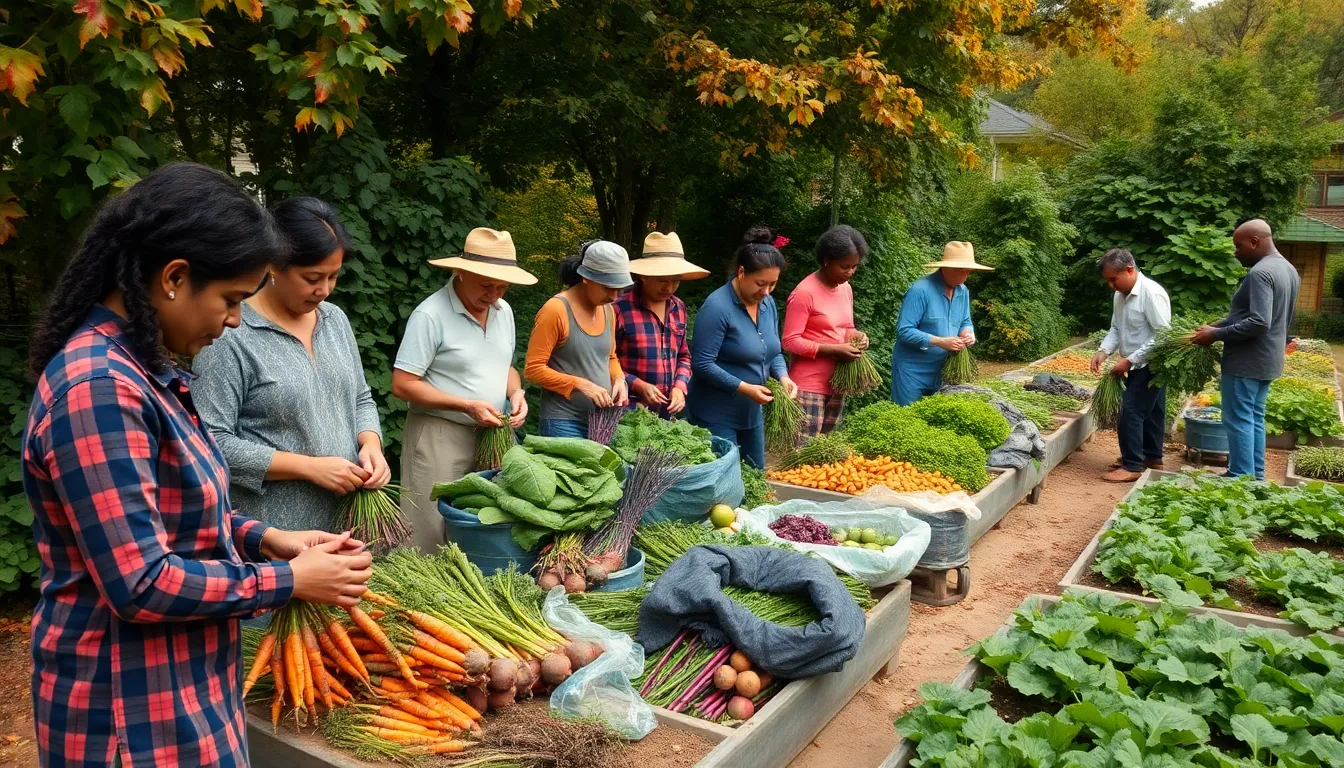
Maximizing our fall garden’s productivity extends far beyond the growing season itself. Strategic harvesting and preservation techniques ensure we’ll enjoy fresh flavors throughout winter while preparing for next year’s abundant harvest.
Timing Your Harvest for Peak Flavor
Monitor weather forecasts closely to protect our crops from unexpected frost damage that can destroy weeks of careful cultivation. Most fall vegetables reach their peak flavor just before the first hard frost hits our gardens.
Harvest root vegetables like beets, carrots, and radishes when they’ve developed their full size but remain tender to the touch. These crops actually improve in sweetness after experiencing light frosts that convert starches to sugars.
Pick leafy greens including lettuce, spinach, and arugula early in the morning when their moisture content peaks and before afternoon sun causes wilting. We can continue harvesting these resilient crops even after light frosts enhance their natural flavors.
Collect brassicas such as broccoli, Brussels sprouts, cabbage, and cauliflower when their heads feel firm and compact but before flowers begin to open. Brussels sprouts taste sweetest after experiencing several light frosts that reduce their natural bitterness.
Storage Methods for Extended Enjoyment
Cool, dry storage works perfectly for root vegetables and winter squash that can last several months in optimal conditions. We should maintain temperatures between 32-40°F with 85-95% humidity for maximum longevity.
Vacuum sealing preserves the quality of delicate leafy greens and prevents moisture loss that leads to wilting and decay. This method extends storage life by removing air that causes oxidation and spoilage.
Freezing maintains nutritional value in brassicas like broccoli and Brussels sprouts when we blanch them briefly before freezing. We can preserve peak flavors for up to 12 months using proper freezing techniques.
| Storage Method | Best Vegetables | Duration | Temperature |
|---|---|---|---|
| Cool, Dry Storage | Root vegetables, squash | 3-6 months | 32-40°F |
| Vacuum Sealing | Leafy greens | 2-3 weeks | 32-35°F |
| Freezing | Brassicas, legumes | 8-12 months | 0°F |
Seed Saving for Next Year’s Garden
Collect seeds from mature plants that have produced our most successful and flavorful crops throughout the growing season. We should select specimens that demonstrated strong disease resistance and vigorous growth patterns.
Allow vegetables to fully mature beyond their typical harvest stage so seeds develop completely before collection. Brassicas need to bolt and produce seed pods, while root vegetables require a full growing season plus overwintering.
Store seeds in airtight containers placed in cool, dry locations where temperatures remain consistently below 50°F. We can use small glass jars with tight-fitting lids or sealed envelopes labeled with variety names and collection dates.
Test seed viability before next year’s planting season by conducting germination tests on small samples. This practice ensures we’re investing time and garden space in seeds that will produce reliable results.
Plan Next Year’s Garden Layout
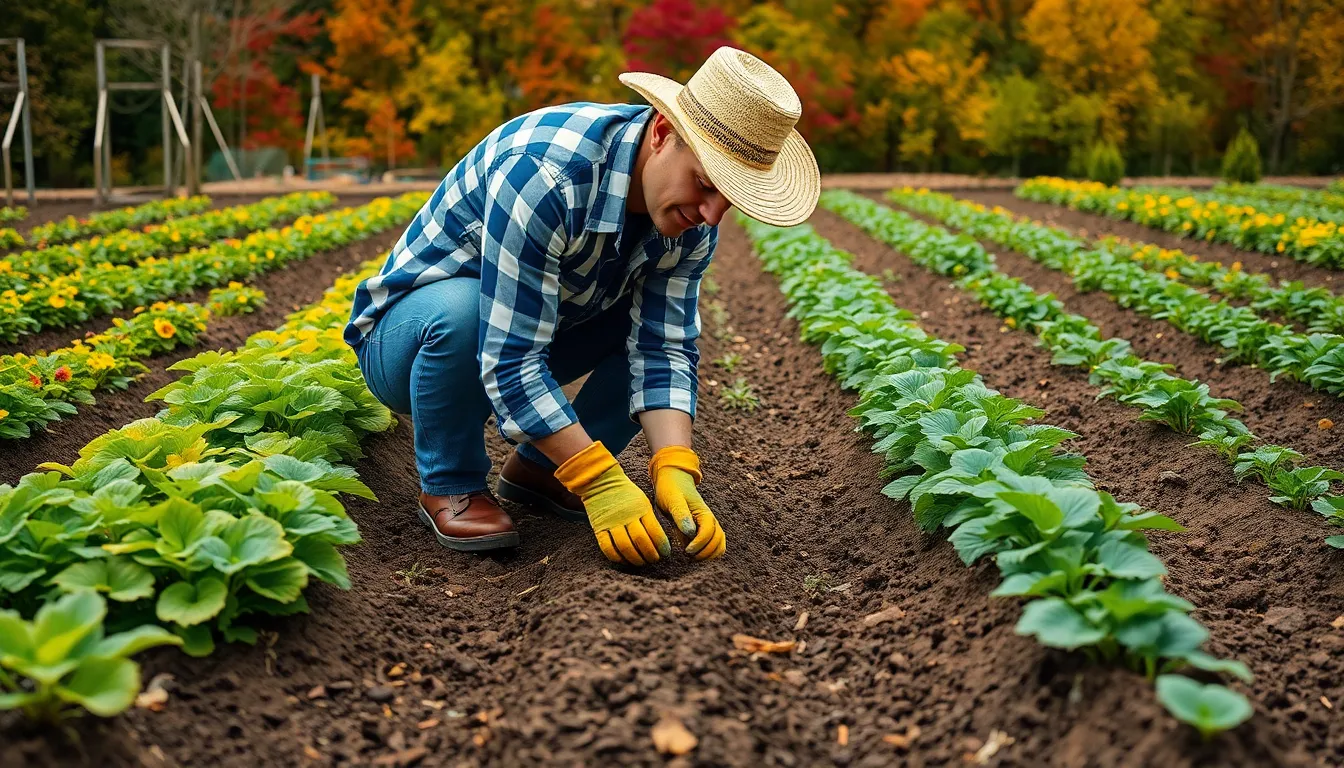
Now that we’ve maximized our fall harvest and preservation efforts, it’s time to strategically plan our garden layout for the coming year. Strategic planning during the fall months ensures we create the most productive and sustainable garden possible.
Crop Rotation Strategies for Soil Health
Rotating plant families prevents soil depletion and breaks pest cycles that can damage our crops year after year. We’ll move Brassicas like broccoli and kale to different garden sections, as these heavy feeders can exhaust soil nutrients when planted in the same location repeatedly.
Legumes become our soil’s best friend by fixing nitrogen naturally, so we’ll plant beans and peas in areas where heavy feeders like tomatoes grew this season. Root vegetables such as carrots and beets should follow leafy greens, as they access nutrients from deeper soil layers that surface feeders can’t reach.
Planning our rotation schedule three to four years in advance maximizes soil health benefits and minimizes disease pressure. We’ll group plants by their nutrient needs, placing light feeders like herbs after heavy feeders to allow soil recovery time.
Documenting This Year’s Successes and Failures
Keeping detailed garden records helps us replicate successes and avoid repeating mistakes in next year’s growing season. We’ll note which varieties produced the highest yields, recording exact cultivar names and seed sources for future reference.
Weather patterns deserve special attention in our documentation, as we’ll track rainfall amounts, temperature extremes, and how different plants responded to seasonal conditions. Pest and disease occurrences should be mapped by location, helping us identify problem areas that need preventive measures or soil amendments.
Recording planting dates alongside harvest dates reveals which timing strategies worked best for our exact climate zone. We’ll photograph our most productive garden areas to remember successful plant combinations and spacing arrangements.
Ordering Seeds and Planning Improvements
Selecting disease resistant varieties reduces our reliance on chemical treatments while improving overall plant health and productivity. We’ll prioritize seeds that performed well in our documented trials, focusing on cultivars adapted to our local growing conditions.
Succession planting schedules require advance planning, so we’ll calculate seed quantities needed for multiple sowings throughout the growing season. Planning improvements like new trellises, raised beds, or irrigation systems during the fall gives us time to source materials and complete projects before spring planting begins.
Companion planting combinations should be finalized now, allowing us to order appropriate seed quantities for beneficial plant partnerships. We’ll create detailed planting schedules that account for each crop’s maturity timeline and space requirements.
Conclusion
Fall gardening opens doors to possibilities that many of us never fully explore. From sweet carrots and crisp leafy greens to stunning chrysanthemum displays and strategic tree plantings we’ve covered the essential elements that make autumn gardening so rewarding.
The key lies in embracing the season’s natural advantages – cooler temperatures fewer pests and ideal conditions for both vegetables and ornamentals. Whether we’re creating vibrant container displays preserving our harvest or planning next year’s layout fall provides the perfect foundation for garden success.
Now it’s time to put these ideas into action. Our gardens are waiting and autumn’s brief but productive window won’t last forever. Let’s make the most of this underutilized season and discover just how bountiful our fall gardens can be.
Frequently Asked Questions
What makes fall gardening better than summer gardening?
Fall gardening offers cooler temperatures, increased rainfall, and fewer pest issues compared to summer. Plants require less watering and many vegetables develop better flavor in autumn conditions. The moderate weather creates ideal growing conditions for cool-season crops and reduces the stress on both plants and gardeners.
Which vegetables grow best in fall gardens?
Cool-season vegetables thrive in fall, including carrots, radishes, turnips, beets, leafy greens (spinach, lettuce, kale), and brassicas (Brussels sprouts, broccoli, cabbage). These crops often produce sweeter, more flavorful harvests than summer varieties, with some like carrots developing their signature sweetness in cooler weather.
How can I create beautiful fall flower displays?
Combine classic autumn flowers like mums and asters for rich colors and textures. Add ornamental kale and cabbage for dramatic foliage, incorporate fall-blooming perennials like chrysanthemums and sedum, and include ornamental grasses and Japanese maples for movement and vibrant seasonal color.
When should I start preparing my garden for winter?
Begin winter preparation about six weeks before the first expected frost. Focus on mulching strategies using materials like straw and burlap, soil amendment with compost, and proper tool maintenance. Strategic timing ensures maximum plant protection while preventing pest issues from premature preparation.
What are the best practices for fall container gardening?
Use warm autumn tones and employ thriller, filler, and spiller arrangements for depth. Incorporate natural elements like pumpkins, gourds, and berry-producing plants. Choose weather-resistant, self-watering containers with adequate size for root insulation during temperature fluctuations.
How do I properly plant trees and shrubs in fall?
Plant woody plants about six weeks before first frost in well-draining soil enriched with organic matter. Maintain consistent moisture during root development, choose native species for climate adaptation, and ensure proper spacing based on mature size, sunlight requirements, and soil conditions.
What’s the best way to harvest and preserve fall vegetables?
Time harvests for peak flavor, especially root vegetables and leafy greens. Use storage methods like cool, dry storage, vacuum sealing, and freezing to extend freshness. Collect seeds from the best specimens for next year’s garden, ensuring proper drying and storage for viability.
How should I plan for next year’s garden during fall?
Document this season’s successes and failures, plan crop rotation strategies for soil health, and order seeds for disease-resistant varieties. Finalize companion planting combinations and plan garden improvements like trellises or irrigation systems to ensure preparedness for the upcoming growing season.







